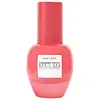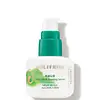What's inside
What's inside
 Key Ingredients
Key Ingredients

 Benefits
Benefits

 Concerns
Concerns

 Ingredients Side-by-side
Ingredients Side-by-side

Water
Skin ConditioningMethylpropanediol
SolventC9-12 Alkane
SolventFragaria Vesca Fruit Extract
AstringentHydroxypropyl Starch Phosphate
Salicylic Acid
MaskingPentylene Glycol
Skin ConditioningMandelic Acid
AntimicrobialSuccinic Acid
BufferingFragaria Vesca Leaf Extract
AstringentAzelaic Acid
BufferingAllantoin
Skin ConditioningSodium Hyaluronate
HumectantBisabolol
MaskingOpuntia Ficus-Indica Flower Extract
Skin ConditioningNiacinamide
SmoothingGlucosamine
Zingiber Officinale Root Extract
MaskingSaccharomyces Ferment
Skin ConditioningDextrin
AbsorbentPolydextrose
Humectant1,2-Hexanediol
Skin ConditioningCaprylyl Glycol
EmollientCoco-Caprylate/Caprate
EmollientHydroxyacetophenone
AntioxidantAmylopectin
Butylene Glycol
HumectantSuccinoglycan
Skin ConditioningLeuconostoc/Radish Root Ferment Filtrate
AntimicrobialLauroyl Lysine
Skin ConditioningSodium Phytate
Lecithin
EmollientAminomethyl Propanol
BufferingXanthan Gum
EmulsifyingCitric Acid
BufferingParfum
MaskingWater, Methylpropanediol, C9-12 Alkane, Fragaria Vesca Fruit Extract, Hydroxypropyl Starch Phosphate, Salicylic Acid, Pentylene Glycol, Mandelic Acid, Succinic Acid, Fragaria Vesca Leaf Extract, Azelaic Acid, Allantoin, Sodium Hyaluronate, Bisabolol, Opuntia Ficus-Indica Flower Extract, Niacinamide, Glucosamine, Zingiber Officinale Root Extract, Saccharomyces Ferment, Dextrin, Polydextrose, 1,2-Hexanediol, Caprylyl Glycol, Coco-Caprylate/Caprate, Hydroxyacetophenone, Amylopectin, Butylene Glycol, Succinoglycan, Leuconostoc/Radish Root Ferment Filtrate, Lauroyl Lysine, Sodium Phytate, Lecithin, Aminomethyl Propanol, Xanthan Gum, Citric Acid, Parfum
Water
Skin ConditioningAloe Barbadensis Leaf Juice
Skin ConditioningHelianthus Annuus Seed Oil
EmollientGlycolic Acid
BufferingGlycerin
HumectantSodium Hydroxide
BufferingPropanediol
SolventGlyceryl Stearate
EmollientOpuntia Ficus-Indica Seed Oil
EmollientRubus Idaeus Seed Oil
EmollientCalophyllum Inophyllum Seed Oil
AntimicrobialCaprylyl Caprylate/Caprate
EmollientCetearyl Glucoside
EmulsifyingLeuconostoc/Radish Root Ferment Filtrate
AntimicrobialLactic Acid
BufferingPhytic Acid
Salicylic Acid
MaskingOryza Sativa Extract
AbsorbentRosa Canina Fruit Oil
EmollientSuperoxide Dismutase
AntioxidantCitrullus Lanatus Fruit Extract
Skin ConditioningVigna Aconitifolia Seed Extract
Skin ConditioningSodium PCA
HumectantLens Esculenta Fruit Extract
Skin ConditioningPyrus Malus Fruit Extract
Skin ConditioningCamellia Sinensis Leaf Extract
AntimicrobialCocos Nucifera Oil
MaskingTocopherol
AntioxidantSea Salt
AbrasiveSodium Lactate
BufferingCitric Acid
BufferingLecithin
EmollientPhenethyl Alcohol
MaskingPotassium Sorbate
PreservativeSodium Benzoate
MaskingMaltodextrin
AbsorbentXanthan Gum
EmulsifyingLeuconostoc Ferment Filtrate
AntimicrobialSodium Hyaluronate
HumectantSodium Carrageenan
Emulsion StabilisingDehydroacetic Acid
PreservativeSilica
AbrasiveBenzyl Alcohol
PerfumingSoybean Peroxidase
AntioxidantWater, Aloe Barbadensis Leaf Juice, Helianthus Annuus Seed Oil, Glycolic Acid, Glycerin, Sodium Hydroxide, Propanediol, Glyceryl Stearate, Opuntia Ficus-Indica Seed Oil, Rubus Idaeus Seed Oil, Calophyllum Inophyllum Seed Oil, Caprylyl Caprylate/Caprate, Cetearyl Glucoside, Leuconostoc/Radish Root Ferment Filtrate, Lactic Acid, Phytic Acid, Salicylic Acid, Oryza Sativa Extract, Rosa Canina Fruit Oil, Superoxide Dismutase, Citrullus Lanatus Fruit Extract, Vigna Aconitifolia Seed Extract, Sodium PCA, Lens Esculenta Fruit Extract, Pyrus Malus Fruit Extract, Camellia Sinensis Leaf Extract, Cocos Nucifera Oil, Tocopherol, Sea Salt, Sodium Lactate, Citric Acid, Lecithin, Phenethyl Alcohol, Potassium Sorbate, Sodium Benzoate, Maltodextrin, Xanthan Gum, Leuconostoc Ferment Filtrate, Sodium Hyaluronate, Sodium Carrageenan, Dehydroacetic Acid, Silica, Benzyl Alcohol, Soybean Peroxidase
 Reviews
Reviews

Ingredients Explained
These ingredients are found in both products.
Ingredients higher up in an ingredient list are typically present in a larger amount.
Citric Acid is an alpha hydroxy acid (AHA) naturally found in citrus fruits like oranges, lemons, and limes.
Like other AHAs, citric acid can exfoliate skin by breaking down the bonds that hold dead skin cells together. This helps reveal smoother and brighter skin underneath.
However, this exfoliating effect only happens at high concentrations (20%) which can be hard to find in cosmetic products.
Due to this, citric acid is usually included in small amounts as a pH adjuster. This helps keep products slightly more acidic and compatible with skin's natural pH.
In skincare formulas, citric acid can:
While it can provide some skin benefits, research shows lactic acid and glycolic acid are generally more effective and less irritating exfoliants.
Most citric acid used in skincare today is made by fermenting sugars (usually from molasses). This synthetic version is identical to the natural citrus form but easier to stabilize and use in formulations.
Read more about some other popular AHA's here:
Learn more about Citric AcidLecithin is a term for a group of substances found in the cell membranes of plants, animals, and humans. They are made up of mixture of phospholipids.
This ingredient has emollient and emulsifying properties.
As an emollient, lecithen helps soften the skin and creates a barrier to keep moisture in.
As an emulsifier, it also helps prevent water and oil ingredients from separating. Lecithin can also help ingredients be better absorbed by the skin.
This is because the phospholipids in lecithin produce liposomes. Liposomes help other ingredients get through the skin barrier.
Depending on the source of this ingredient, lecithin may not be fungal acne safe. This is because some sources of lecithin come from soybean oil, which may feed the malassezia yeast that feeds fungal acne.
We recommend reaching out to the brand you are purchasing from to inquire about the source of their lecithin.
Some other names for this ingredient include soy lecithin and deoiled soy lecithin.
Learn more about LecithinLeuconostoc/Radish Root Ferment Filtrate is a natural preservative. It comes from fermenting radish roots with a bacteria called leuconostoc.
Leuconostoc comes from lactic acid.
This ingredient has antimicrobial properties and helps prevent the growth of bacteria in a product.
Leuconostoc is used to make the traditional Korean side-dish, kimchi. It is also used to make sourdough bread (both incredibly yummy foods).
Learn more about Leuconostoc/Radish Root Ferment FiltrateSalicylic Acid (also known as beta hydroxy acid or BHA) is a well-known ingredient for treating skin that struggles with acne and clogged pores. It exfoliates both the skin's surface and deep within the pores to help clear out buildup, control oil, and reduce inflammation.
Unlike AHAs (alpha hydroxy acids), salicylic acid is oil-soluble. This allows it to penetrate into pores which makes it especially effective for treating blackheads and preventing future breakouts.
Salicylic acid is also known for its soothing properties. It has a similar structure to aspirin and can calm inflamed or irritated skin, making it a good option for acne-prone skin that is also sensitive.
Concentrations of 0.5-2% are recognized by the U.S. FDA as an over-the-counter topical acne product.
It can cause irritation and/or dryness if one's skin already has a compromised moisture barrier, so it's best to focus on repairing that before introducing this ingredient into your routine.
While salicylic acid does not increase sun sensitivity, it’s still important to wear sunscreen daily to protect your skin.
If you are looking for the ingredient called BHA or Butylated Hydroxyanisole, click here.
Learn more about Salicylic AcidSodium Hyaluronate is hyaluronic acid's salt form. It is commonly derived from the sodium salt of hyaluronic acid.
Like hyaluronic acid, it is great at holding water and acts as a humectant. This makes it a great skin hydrating ingredient.
Sodium Hyaluronate is naturally occurring in our bodies and is mostly found in eye fluid and joints.
These are some other common types of Hyaluronic Acid:
Learn more about Sodium HyaluronateWater. It's the most common cosmetic ingredient of all. You'll usually see it at the top of ingredient lists, meaning that it makes up the largest part of the product.
So why is it so popular? Water most often acts as a solvent - this means that it helps dissolve other ingredients into the formulation.
You'll also recognize water as that liquid we all need to stay alive. If you see this, drink a glass of water. Stay hydrated!
Learn more about WaterXanthan gum is used as a stabilizer and thickener within cosmetic products. It helps give products a sticky, thick feeling - preventing them from being too runny.
On the technical side of things, xanthan gum is a polysaccharide - a combination consisting of multiple sugar molecules bonded together.
Xanthan gum is a pretty common and great ingredient. It is a natural, non-toxic, non-irritating ingredient that is also commonly used in food products.
Learn more about Xanthan Gum